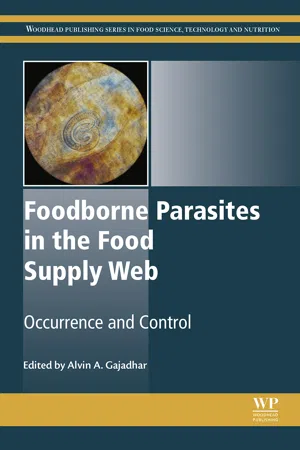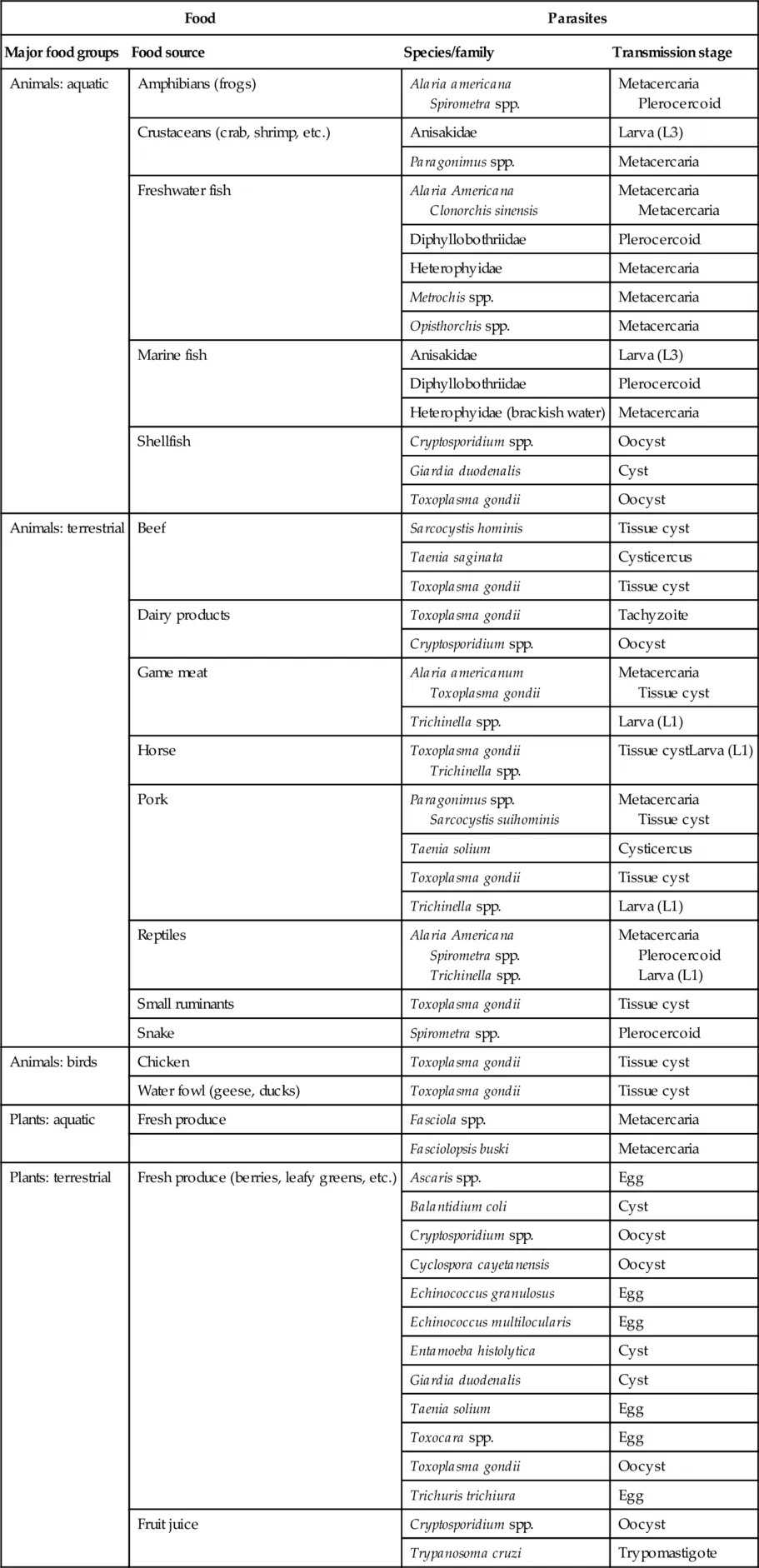
This is a test
- 482 pages
- English
- ePUB (mobile friendly)
- Available on iOS & Android
eBook - ePub
Book details
Book preview
Table of contents
Citations
About This Book
Foodborne Parasites in the Food Supply Web: Occurrence and Control provides an overview of the occurrence, transmission, and control of parasites in the food chain, including an introduction to the topic from the perspectives of various issues surrounding foodborne parasites. The text then explores the different types of foodborne parasites, the dynamics of parasite transmission in different food sources, and the prevention and control of foodborne parasites in the food chain.
- Provides an overview of the occurrence, transmission, and control of parasites in the food chain
- Explores the different types of foodborne parasites and the dynamics of parasite transmission in different food sources
- Highlights prevention and control methods to ensure the safety of the food chain
Frequently asked questions
At the moment all of our mobile-responsive ePub books are available to download via the app. Most of our PDFs are also available to download and we're working on making the final remaining ones downloadable now. Learn more here.
Both plans give you full access to the library and all of Perlego’s features. The only differences are the price and subscription period: With the annual plan you’ll save around 30% compared to 12 months on the monthly plan.
We are an online textbook subscription service, where you can get access to an entire online library for less than the price of a single book per month. With over 1 million books across 1000+ topics, we’ve got you covered! Learn more here.
Look out for the read-aloud symbol on your next book to see if you can listen to it. The read-aloud tool reads text aloud for you, highlighting the text as it is being read. You can pause it, speed it up and slow it down. Learn more here.
Yes, you can access Foodborne Parasites in the Food Supply Web by Alvin A Gajadhar in PDF and/or ePUB format, as well as other popular books in Technology & Engineering & Food Science. We have over one million books available in our catalogue for you to explore.
Information
Part One
Perspectives
1
Introduction to foodborne parasites
A.A. Gajadhar Canadian Food Inspection Agency, Saskatoon, SK, Canada
Abstract
Parasites transmitted by food are increasingly recognized as a global threat to food safety and trade. Phylogenetically and biologically, parasites represent one of the most diverse groups of pathogens. Unlike bacteria and viruses, they are typically endowed with structural and functional attributes that facilitate their survival, replication, and transmission in the food web. These characteristics, in addition to the globalization of the food supply, the increasing trend of consuming fresh, ready-to-eat food, the general lack of knowledge of parasites, and the paucity of practical diagnostic and effective control methods have all led to the understanding that foodborne parasites are among the most neglected global pathogens affecting humans. Basic information to inform readers about foodborne parasites is an essential introductory step to understanding the occurrence and control of these parasites and their importance to consumers, the industry, and its regulators.
Keywords
Food safety
Foodborne
Parasites
Pathogens
Neglected diseases
Socio-economic impact.
1.1 Introduction
A safe food supply is essential to the survival of humankind. As people have multiplied and technology has advanced, the food supply has evolved from a base of local consumer production to large-scale integrated production and distribution practices. Consumers, particularly those in urban regions, are largely unaware of the origin and processing of their food. Similarly, most producers are unaware of the variety of potential public health hazards that are transmissible by food. Both consumers and producers rely on government regulations and oversight for guidance and protection. Although information regarding foodborne hazards is widely available from many sources, especially regarding hazards such as bacteria and chemical residues, there is limited information on foodborne parasites. This is becoming an urgent matter as the food supply web is now global and expertise in parasitology in developed countries has waned. This complacency has been driven primarily by improved hygiene standards and the increasingly effective control of zoonotic parasites in food animals in those regions. This chapter introduces the diversity and unique characteristics of foodborne parasites, the food vehicles by which they are transmitted, and their significance to consumers. A ranking of these foodborne parasites by various socioeconomic factors and information relevant to their control are presented.
The world’s population currently exceeds 7 billion consumers living in regions where foodborne parasites are endemic or where there is risk of infection from imported food. Yet, relatively little is known about parasites, and their identity and characteristics are often confused with those of bacteria and viruses. Parasites are eukaryotic organisms that are classified within diverse taxa ranging from single-cell protozoa to complex hermaphroditic helminths. Foodborne parasites that are prevalent globally or regionally include the flagellated protozoon Giardia, the coccidian protozoa Cryptosporidium and Toxoplasma, the roundworms (nematodes) Trichinella and Anisakis, the tapeworms (cestodes) Taenia and Echinococcus, and the flukes (trematodes) Opisthorchis, Clonorchis, and Fasciola. The diversity of their structural and life-cycle characteristics that are employed in astounding strategies for survival, transmission, host adaptation, and replication makes parasites difficult to control but also fascinating to study.
1.2 Parasites transmitted by food
Human parasitic infections originate from many sources and are acquired by various modes of transmission. Oral transmission via food and water represents the most common route of infection. Because food is produced globally in a wide range of microenvironments, and because it originates from a variety of aquatic or terrestrial animals and plants, there is a diverse range of strategies for parasite survival, replication, and transmission. A list of various food products and examples of the parasites they transmit is provided in Table 1.1. Although many waterborne parasites such as Giardia and Entamoeba have simple, direct life cycles, foodborne parasites often have life cycles that involve multiple stages and various host species that exploit both the exogenous and endogenous environments and food habits of consumers. Generally, meatborne parasites replicate and attain infectivity in protective structures such as cysts within muscle, established during the animal’s development (Table 1.1). Examples include Toxoplasma gondii, Sarcocystis hominis, and Trichinella spiralis. Other parasites such as Giardia and Cryptosporidium can infect consumers by contaminating surfaces of ready-to-eat fruits and vegetables.
Table 1.1
Food groups and products that can serve as transmission vehicles for parasites capable of infecting consumers
| Food | Parasites | ||
| Major food groups | Food source | Species/family | Transmission stage |
| Animals: aquatic | Amphibians (frogs) | Alaria americana Spirometra spp. | Metacercaria Plerocercoid |
| Crustaceans (crab, shrimp, etc.) | Anisakidae | Larva (L3) | |
| Paragonimus spp. | Metacercaria | ||
| Freshwater fish | Alaria Americana Clonorchis sinensis | Metacercaria Metacercaria | |
| Diphyllobothriidae | Plerocercoid | ||
| Heterophyidae | Metacercaria | ||
| Metrochis spp. | Metacercaria | ||
| Opisthorchis spp. | Metacercaria | ||
| Marine fish | Anisakidae | Larva (L3) | |
| Diphyllobothriidae | Plerocercoid | ||
| Heterophyidae (brackish water) | Metacercaria | ||
| Shellfish | Cryptosporidium spp. | Oocyst | |
| Giardia duodenalis | Cyst | ||
| Toxoplasma gondii | Oocyst | ||
| Animals: terrestrial | Beef | Sarcocystis hominis | Tissue cyst |
| Taenia saginata | Cysticercus | ||
| Toxoplasma gondii | Tissue cyst | ||
| Dairy products | Toxoplasma gondii | Tachyzoite | |
| Cryptosporidium spp. | Oocyst | ||
| Game meat | Alaria americanum Toxoplasma gondii | Metacercaria Tissue cyst | |
| Trichinella spp. | Larva (L1) | ||
| Horse | Toxoplasma gondii Trichinella spp. | Tissue cystLarva (L1) | |
| Pork | Paragonimus spp. Sarcocystis suihominis | Metacercaria Tissue cyst | |
| Taenia solium | Cysticercus | ||
| Toxoplasma gondii | Tissue cyst | ||
| Trichinella spp. | Larva (L1) | ||
| Reptiles | Alaria Americana Spirometra spp. Trichinella spp. | Metacercaria Plerocercoid Larva (L1) | |
| Small ruminants | Toxoplasma gondii | Tissue cyst | |
| Snake | Spirometra spp. | Plerocercoid | |
| Animals: birds | Chicken | Toxoplasma gondii | Tissue cyst |
| Water fowl (geese, ducks) | Toxoplasma gondii | Tissue cyst | |
| Plants: aquatic | Fresh produce | Fasciola spp. | Metacercaria |
| Fasciolopsis buski | Metacercaria | ||
| Plants: terrestrial | Fresh produce (berries, leafy greens, etc.) | Ascaris spp. | Egg |
| Balantidium coli | Cyst | ||
| Cryptosporidium spp. | Oocyst | ||
| Cyclospora cayetanensis | Oocyst | ||
| Echinococcus granulosus | Egg | ||
| Echinococcus multilocularis | Egg | ||
| Entamoeba histolytica | Cyst | ||
| Giardia duodenalis | Cyst | ||
| Taenia solium | Egg | ||
| Toxocara spp. | Egg | ||
| Toxoplasma gondii | Oocyst | ||
| Trichuris trichiura | Egg | ||
| Fruit juice | Cryptosporidium spp. | Oocyst | |
| Trypanosoma cruzi | Trypomastigote | ||
Most foodborne parasites in food animals or the external environment have stages that are capable of survival in a variety of conditions for long periods of time. For example, coccidian protozoa are protected immunologically as they develop within host cells and are located in sites to facilitate replication and exit from the host or to allow for long-term survival in the host. Trichinella spp. larvae also develop within the protective environment afforded by host cells, and most species remain encapsulated as such until consumed by a new host. Many species of cestodes and trematodes are also protected in enclosures such as cysts and eggs in their respective hosts, environments, or food products as they await transmission to consumers. Exogenous stages of many species of parasites can resist a wide range of chemicals and survive for long periods of time under various environmental conditions such as mild heat and extreme cold, drought, and seasonality (Gajadhar and Allen, 2004). Therefore, strategies and measures traditionally used for controlling other foodborne pathogens are often ineffective for parasites. The unique characteristics of their life cycles, and the epi...
Table of contents
- Cover image
- Title page
- Table of Contents
- Copyright
- List of contributors
- Woodhead Publishing Series in Food Science, Technology and Nutrition
- Part One: Perspectives
- Part Two: Parasites
- Part Three: Transmission dynamics in food sources
- Part Four: Prevention and Control
- Index
